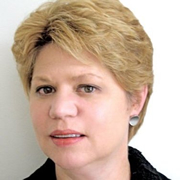 I had the great the opportunity to interview Lori Wizdo, B2B marketing analyst at Forrester Research. Lori is a senior analyst with extensive marketing, sales, and operation experience in the information systems and software industries.
I had the great the opportunity to interview Lori Wizdo, B2B marketing analyst at Forrester Research. Lori is a senior analyst with extensive marketing, sales, and operation experience in the information systems and software industries.
In our discussion, Lori shared key insights into the B2B buyer's journey as well as marketing and sales alignment.
There's a lot of discussion in the marketplace about articles you've written, including "The Lead-Nurturing Payoff For The Tech Industry." In that article and elsewhere, you've suggested that many buyers get as far as 70 percent through the sales cycle before they find it useful to engage the sales teams. Does that figure depend on the type of solution? Does the complexity of the solution change things?
I’ve actually started to put some disclaimers around statements like “60 percent” or “70 percent” or “two-thirds of the way.” Although calling this an urban legend might be too strong, in the marketing zeitgeist, this said a lot. We have some research to indicate that’s true, and that the statement’s directionally correct.
Marketing needs to do a better job of communicating on a one-to-one level and connecting what our products and services can do to make people happy. It’s directionally correct to make that point. But, like any average, it’s wrong. However, it’s an important belief to take on board because it changes our belief about our need to communicate in the earliest stages of the sales cycle.
Forrester does a great deal of buyer journey research on sources of influence in a lot of other dimensions:
First, buyers do like to talk to vendors early in the process. They don’t like to be “sold to,” but they do like to talk to vendors because they see vendors as authorities in technology categories. But that’s much more likely to happen when a vendor has an existing relationship with a customer. If they have that experience with a vendor, the customer has more trust that they’re not going to get “sold to.” They’re less likely and more reluctant to talk to a new vendor, because they expect that vendor’s going to try to close them.
Second, behavior changes depending on whether customers think they know how to buy. For instance, people might think they know how to evaluate something like network optimization software. But they don’t know everything about recommendation engines. How they act with a vendor depends on if they think they know how to buy.
This is an important belief for marketers to take onboard because it changes our perception of how we need to communicate early in the sales cycle.
In many companies, particularly larger companies, there's a total disconnect between marketing and sales. Some sales professionals even believe that they can't get qualified leads from marketing. Do you see this changing? What's your outlook regarding this issue?
First off, I don’t see a lot of change in this area over the next year. There’s a big difference between what marketing sees as a lead right now, in general, which they often see as someone responding to something we sent out there that was relatively targeted.
Twenty years ago, people would just buy a list and call it leads. That’s a big improvement. Of course, that’s still nowhere near what a sales person would consider a lead.
We’ve got to firmly understand the leaks and the mistrust between marketing and sales over leads. Marketeers don’t always have the greatest track record for delivery. When we survey marketeers, we ask what percent of their pipeline was the result of a marketing program. That number was 50 percent this year, and it was only 38 percent last year. The number came up quite a bit, but it’s still pretty low. Smaller companies might be doing something like 90 or 70 percent, and I’ve even met clients who have 100 percent of their pipeline coming from marketing.
In large global companies, sales professionals haven’t seen leads from marketing, ever. Those companies will answer that question in the range of 5 to 15 percent. In general, that’s why marketing doesn’t have a track record of providing pipeline-impacting leads to sales.
I think marketing has an opportunity to change that, because we now can manage engagements through nurturing. We have ways to engage with customers who aren’t ready to start a buying process. If a customer’s not ready to start a buying process, a sales rep—rightfully—doesn’t give that customer a lot of attention, because they’re supposed to bring in this quarter’s business. We celebrate them when they do, and we punish them dramatically when they don’t. So it’s not in their best interest to work on leads that aren’t going to close this quarter.
The problem is that marketing hasn’t had the processes to do anything about that. Thanks to some great, new marketing automation technologies that are out there, we can engage with those customers and teach them how to buy when they’re in the early stages. We have the ability to control that engagement. One of the changes I think we’ll see this year is a lot more behaviorally aware, contextually sensitive engagements where lead scoring will play a role along with other behavioral signals.
I see people moving beyond campaigns. People will still do their four-step campaigns, but they might hold on to leads from marketing more while tightening up their lead scoring. I still think marketers are erring on the side of sending leads to sales when they’re still immature, largely because there’s still a clamor from sales: “gimme leads, gimme leads, gimme leads.” Even though the sales reps think they’re empty calories, they’re still drinking the soda. It’s going to take more than a couple of years for that to change.
I talked to someone who recently left SAP, who told me that four out of five leads that landed on his desk weren't qualified. One of the things we tell our clients is that many companies misuse marketing automation, because it's so difficult to get it right. But, if you are going to score leads, you need to validate and calibrate the scoring not using marketing automation because you can miss things. Do you think the level of sophistication of use of marketing automation software is hand-in-hand with the improvement you see?
I would agree that senior people are less likely to give up certain information because they don’t want the callback, and they’d rather have their people get the follow-up details. You’re less likely to find them popping up as a 98 on the lead score meter.
But, the underlying thing is that I never recommend that someone only use digital touches as a nurturing strategy. Successful companies are able to use human touches as well as digital touches as part of a nurturing strategy. That means someone like an inside sales rep or a business development rep calls and is more like a concierge.
It’s now the job of marketing to guide the buyer through the buying process. I have this concierge image in my head, of someone who calls a prospect to say “I see you’re downloading a lot of stuff for evaluation. Are you finding what you need?”
What’s wrong is when that human touch is from someone whose goals are guided by this quarter’s or even this year’s objectives. They’ll ask if they can perform a demo, and that’s where it goes all wrong. The buyer just isn’t at that stage, yet. For more complex sales, I can’t imagine a situation where someone shouldn’t have human touches in their nurturing. For low value, transactional sales, you should at least have a chat window on your website. Buyers need to talk to people to get information. It doesn’t all come across digitally. You need that human qualification.
I get calls from third-party companies that contact me on behalf of large organizations, and the calls are just awful. Do senior executives at companies not understand this problem, and the tremendous issue with waste?
Senior executives have a right to think that their directors and their marketing people are figuring this out. I think what they don’t realize is how hard this is. But the CEO of a multi-million dollar company should not be worrying about leads.
I think that for the marketeers, this is very difficult. There’s a continuing tension where the sales team says “give me more money for more salespeople. I’ll do more with that.” But you can’t scale that forever.
Without marketing automation, the ability to scale, the ability to standardize, the ability to see what works, how do we expect people to get better? How good was inventory control in 1970, before you had perpetual inventory systems? It was virtually nonexistent. Realistically, you can’t get better at anything you can’t standardize, optimize, and learn from. We haven’t been at that point, except within the last ten years.
Just having technology makes you a little bit better, because you can eliminate the low hanging fruit. You can’t fix that twice. In order to get significantly better, there’s also a mindset happening in marketing that I think almost everybody I talk to is beyond some “smash and blast,” four-step campaign that generates a lead. They know they have to engage customers on the basis of their outcomes, their needs, and their challenges, not on the product capabilities. We’re trying to create content that does that. Building those programs and learning what works is where improvement will happen over the next several years.
One of the primary reasons why CRM doesn't work the way companies would like it to work is that the average close rate on a fully qualified sales lead is about 20 percent, but that still means a sales rep has to sign up for losing four out of five times. If you ask a sales rep how many deals they'll close, they'll tell you 60 or 80 percent. But that only means a percentage of the deals they thought they would close, because they're not willing to give someone the ability to see that they're losing four out of five sales. Instead of being a hero for winning three out of ten times, they're the heel, and they get penalized. Even if marketers do a fantastic job, should sales people have the ability to accept or reject leads so those leads can be more effectively nurtured?
I think there needs to be recognition that “leads qualified” and “leads accepted” are two different phases. For some kinds of industries, sales might qualify the lead before they accept it, because those leads are hard to really qualify. In other cases, even if it's sales qualified, sales shouldn't touch it and if it doesn't get accepted after a period of time then there is a reason and it should go back to marketing for further qualification. Sales people are very good at sorting out short term opportunities. That’s how they survive. There need to be controls and I believe there is a way to sort things out so sales doesn't ignore marketing leads.
In summary, Wizdo highlights key calls to action for B2B marketing and sales management:
- Talk to buyers early in the cycle; not the hard-sell, but guide like a concierge
- B2B marketing and sales teams must agree on the sales-ready lead definition
- Marketers must use behavioral signals to apply lead scoring
- Use human touches as well as digital touches in nurturing strategies
- Standardize, optimize and learn from marketing automation
How does your B2B marketing team apply these ideals? Do you agree with Wizdo’s points? We appreciate and welcome your comments.
By Dan McDade
Topics: Lead Generation, B2B Marketing, Marketing & Sales Alignment, B2B Sales, Lead Management





